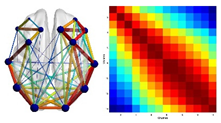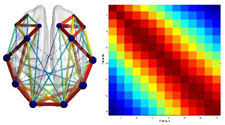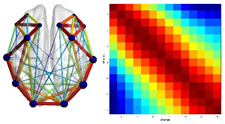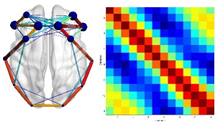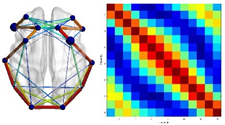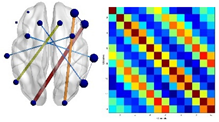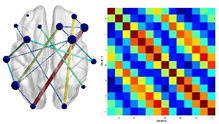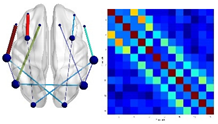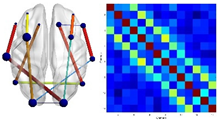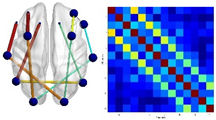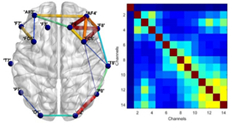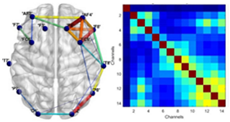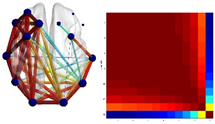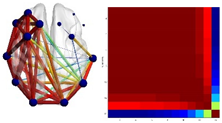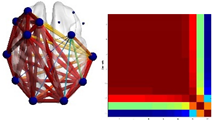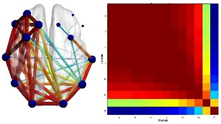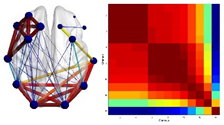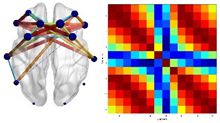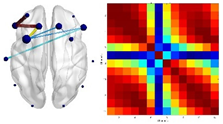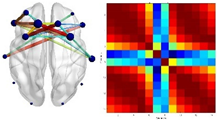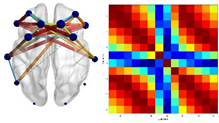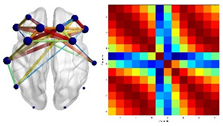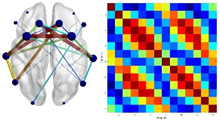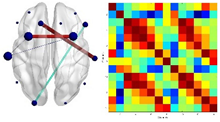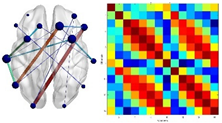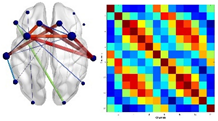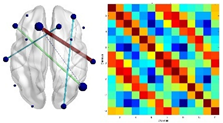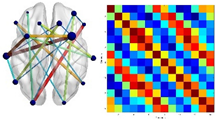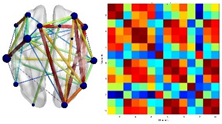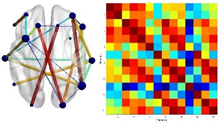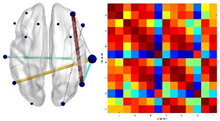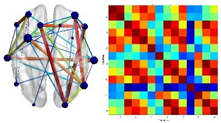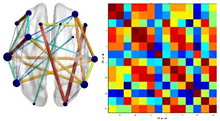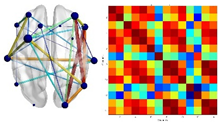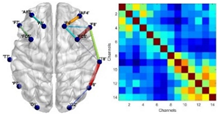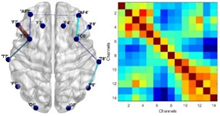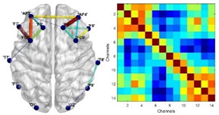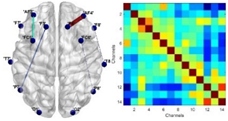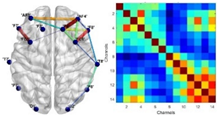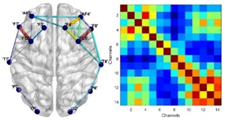Abstract
Music is considered a powerful brain stimulus, as listening to it can activate several brain networks. Music of different kinds and genres may have a different effect on the human brain. The goal of this study is to investigate the change in the brain’s functional connectivity (FC) when music is used as a stimulus. Secondly, the effect of listening to the subject’s favorite music is compared with listening to specifically formulated relaxing music with alpha binaural beats. Finally, the effect of the duration of music listening is studied. Subjects’ electroencephalographic (EEG) signals were captured as they listened to favorite and relaxing music. After preprocessing and artifact removal, the EEG recordings were decomposed into the delta, theta, alpha, and beta frequency bands, and the grand-averaged connectivity matrices were generated using Inter-Site Phase Clustering (ISPC) for each frequency band and each type of music. Furthermore, each lobe of the brain was analyzed separately to understand the effect of music on specific regions of the brain. EEG-FC among different channels was accessed by using graph theory and Network-based Statistics (NBS). To determine the significance of the changes in brain networks after listening to music, statistical analysis was conducted using Analysis of Variance (ANOVA) and t-test. The study of listening to music for a short duration verifies that either favorite or preferred music can affect the FC of the subject and induce a relaxation state. The short duration study also verifies a significant (ANOVA and t-test: p < 0.05) effectiveness of relaxing music over favorite music to induce relaxation and alertness in the subject. In the study of long duration, it is concluded that listening to relaxing music can increase functional connectivity and connections strength in the frontal lobe of the subject. A significant increase (ANOVA and t-test: p < 0.05) in FC in alpha and theta band and a significant decrease (ANOVA and t-test: p < 0.05) in FC in beta band in the frontal and parietal lobe of the brain verifies the hypothesis that the relaxing music can help the subject to achieve relaxation, activeness, and alertness.
1. Introduction
Music is considered a source of entertainment and a potent stimulator of brain waves. Research has shown that music can have a strong effect on humans. It can relieve anxiety [1], depression [2], and stress [3]; enhance mood [4]; and increase spatial awareness [5]. With the development of smartphones and other gadgets, music is very easily assessable through the Internet worldwide. Interestingly, the genre of music can be important. Different genres of music affect the human brain differently [6]. Slow and quiet music, especially classical music, can relax the mind and body of a subject [7], and the listener enters a deeply relaxed state. This can be useful for physiological functions, such as decreasing the heart rate, blood pressure, and the secretion of stress hormones [8]. Music can also help in expressing emotions. Hotels and restaurants play background music to enhance the customer’s interest [9]. Playing music can enhance the taste of food as well as keep the customer calm while waiting for the food. It is also said that the pace of music can impact the eating rhythms. Due to its wide availability, music has become an easy stress-reduction tool. Researchers have been studying the effect of music, mood [10], and rhythms using EEG. Loud and noisy music can increase the blood flow rate, blood pressure, and heartbeat of a person [11]. Music can also be used as a cure for some mental disorders. Listening to favorite music can invoke the damaged portion of a stroke patient’s brain [12] and hence can be used as a method of recovery. Stress is a normal feeling, but prolonged stress can harm physical health as well as the mood and behavior of the subject [13]. Depression, anxiety, learning disabilities, and autism can potentially be cured by using music-based NFT [14,15,16].
With the advance in neuroimaging techniques, the effect of music on the brain can now be studied. Electroencephalogram (EEG) is a non-invasive electrophysiological neuroimaging technique to detect the electrical activities in the brain using electrodes placed on the scalp. The human brain communicates using electrical impulses that can be recorded using EEG sensors/electrodes. Brain network analysis, a technique that investigates different mechanisms taking place inside the brain, is considered a promising tool. The large-scale connections between different brain regions within different oscillations can provide insight into the behavior of the brain.
A human brain is sub-categorized into different regions. Each region of the brain is responsible for some specific tasks. For example, in cases of depression and anxiety, improved connectivity amongst the amygdala and hippocampus has been seen [17]. The study of FC of a brain indicates the correlation between and within two or more active regions of the brain [18]. It can also signify the active regions of the brain. FC is intensively used in neuroimaging to understand the neural interaction inside a brain. It is used to characterize within and between the regions of a brain. The measurement of changes in EEG and functional Magnetic Resonance Imaging (fMRI) in patients as well as healthy subjects are used to investigate brain FC in response to music [19,20,21]. Earlier, it was considered that the FC remains static in time, but recent studies have shown that FC is dynamic [22,23]; i.e., it changes over time. This indicates that it can be influenced by some outer/external conditions or stimuli.
In this study, music is used as a stimulus to study the functional connectivity (FC) of the subjects. Brain connectivity architecture can reveal a great deal of information about the subject’s behavior, mood, attention level, and much more. Computational techniques, particularly those based on graph theory, have lately played a key role in gaining a better understanding of brain connection architecture [24]. In this research, the subjects selected music of their preference called favorite music, which can be from any genre, and another music was pre-selected by the researcher, called relaxing music. These two pieces of music were used as a stimulus to study their effect on the brain. We then compared the significance of relaxing music over favorite music. In addition, the effect of the duration of music listening over functional connectivity was also studied. A preliminary study using the same dataset was conducted by Nawaz et al. [25], in which the time-series analysis using entropy and changes in alpha band power in response to music was analyzed. The main contribution of the study conducted by Nawaz et. al. was to investigate the EEG dynamics under different music stimuli. A better soothing effect was achieved by using relaxing music in that study, and it was also observed that listening to relaxing music for a longer period can cause more significant change. Recently, a convolutional neural network has been used on the EEG data for the classification of subjects listening to music from that of subjects without auditory input as well as for differentiating the EEG of subjects listening to different music [26]. However, the connectivity analysis was still left to explore. This research explores the effect of listening to favorite and relaxing music by analyzing the overall change in FC, change in FC within the lobes, and change in FC within different frequency bands, and towards the end of this paper, a comparison is conducted between the two studies.
2. Materials and Methods
2.1. Experiment Design
The experiment was divided into two parts: a study of short duration and a study of long duration. Everyone has their preferences when it comes to music. In the study of short duration, the subject listened to his/her favorite music and relaxing music while EEG signals were recorded. In the study of long duration, the subjects were split up into Music Listening and Control Group, which did not listen to the music. The Music Listening Group listened to the relaxing music daily for at least half an hour for two consecutive weeks. EEG recordings were collected before the start of the experiment, which is referred to as baseline; then again after one week of the experiment, and again at the end of the experiment after two weeks.
Before conducting the experiments, the study was approved by the scientific and ethical review committee of the university under the reference number UTAR/FEGT/EE/2015/H1. All techniques used in studies involving human subjects complied with the institutional and national research committee’s ethical requirements as well as the 1964 Helsinki Declaration and its subsequent modifications or similar ethical standards.
2.2. Music Stimuli
Music preferences are very personalized and culturally diverse. Everyone has his/her favorites when it comes to music. Music of different genres can vary considerably in melodic and choral features and rhythmic complexity. Memories and thoughts can be interlinked with favorite music and can be evoked by listening to that music regardless of the genre of the music [27]. The response of individuals may differ to the same kind of music. For example, classical music may help some people to feel calm and relaxed, while others may feel differently. In this experiment, the subjects were free to choose their favorite music, and the distribution of the genre of the selected music is shown in Figure 1.
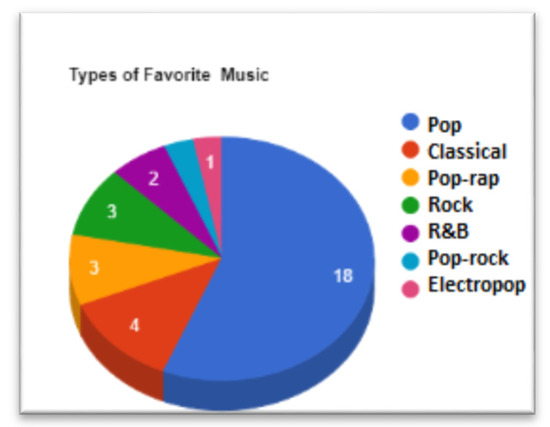
Figure 1.
Statistics of selected favorite music genre.
The second music utilized in this study was specially designed calming music with binaural beats (alpha brainwave range, 8–13 Hz), which can induce a state of relaxation in individuals (https://www.youtube.com/watch?v=03DN380MhXk, accessed on 25 June 2015); hence, we call this relaxing music. Listening to music with binaural beats can cause many regions of the brain to function in unison, allowing the individual to attain a state of calm [1]. When compared to their favorite music, listening to relaxing music had a more calming effect on the subjects [4], reduced mental fatigue [28], and improved working memory and cortical connectivity [29]. Hence, in the study of long duration, only relaxing music was used as a stimulus.
2.3. Participants
To obtain the required EEG dataset, volunteer participants were selected from the Faculty of Engineering and Green Technology, Universiti Tunku Abdul Rehman. The cortical response of musician and non-musician subjects is different [30]; hence, all the participants selected for this study were non-musicians. After explaining all the experimental procedures, all the participants submitted a written signed consent. For the study of short duration, there was a total of 32 participants, from which five subjects were omitted due to inconsistency and artifacts in the recorded EEG data. Out of these 32 participants, there were 27 males and five females. The participants’ mean age was 24.1 ± 7.63 years. Similarly, for the study of long duration, there was a total of 10 participants from which one subject was excluded due to inconsistency and artifacts in the recorded EEG data. Out of these 10 participants, there were eight males and two females. The participants’ mean age in the Control Group was 34.6 ± 17.05 years, and for the Music Listening Group, the mean age was 33.3 ± 14.47 years.
2.4. EEG Recordings
EEG was recorded in a silent room. Emotiv EPOC headset was used to record the EEG signals as shown in Figure 2a). The headset has 14 active and two reference electrodes. These electrodes were placed on the scalp of the subject following the international 10–20 system. The sensor electrodes are positioned at AF3, AF4, F3, F4, F7, F8, FC5, FC6, P7, P8, T7, T8, O1, O2, P3 (CMS), and P4 (DRL) positions as illustrated in Figure 2b. Here, P3 and P4 are the reference electrodes. A 128-Hz sampling rate was used to acquire the EEG data. Although the headset has a slightly lower signal-to-noise ratio [31], the EEG recordings are comparable to the high-end EEG acquisition tools and hence can be used for the research [32]. The reason behind the use of the Emotiv EPOC headset is its easy setup and affordable price. In the future, we intend to create an easy-to-use setup that may be used by the public to monitor and enhance their mental health, in which case, this headset was the most convenient option available.

Figure 2.
(a) Emotiv Epoc headset; (b) position of EEG electrodes on the human scalp.
In the study of the short duration, the baseline EEG signals of the subjects were recorded for 3 min before listening to the music. After a 5-min break, the subject listened to his/her favorite music while another 3-min round of EEG signals was recorded. Again, after a 5-min break, the subject listened to relaxing music while another 3-min round of EEG signals was recorded. Figure 3 shows the flow diagram of the study of short- and long-duration studies.
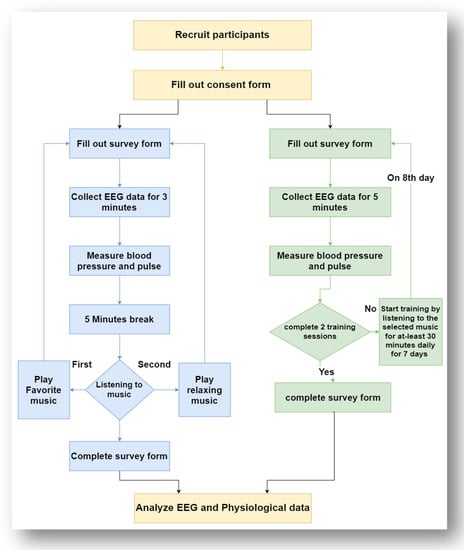
Figure 3.
Flow chart of short-duration (blue) and long-duration (green) experiments.
In the study of the long duration of the effect of music for EEG-FC, the baseline EEG signals of the subjects in the Control and Music Listening Groups were recorded for five minutes before listening to music. The subjects in the Music Listening Group then listened to the selected music for at least half an hour for seven consecutive days. On the eighth day, the EEG signals of the subjects in the Control and Music Listening Groups were recorded for five minutes. Again, the subjects in the Music Listening Group listened to the selected music for a minimum of half an hour for another seven consecutive days, and on the fifteenth day, EEG of Control and Music Listening Groups were recorded. Figure 3 shows the flow diagram of the study of long duration.
2.5. Preprocessing
The raw EEG signals recoded using the Emotiv EPOC headset were required to be cleaned. The artifacts can be present in the data due to muscle movement, eye blinks, and eye movements. These artifacts can be filtered out by adopting multiple methods. The electrical noise created by facial muscle movement is called an electromyogram (EMG), whereas the electrical noise induced by eye activities is called an electrooculogram (EOG). Many advanced approaches for removing artifacts have been published in the literature. For real-time automated EEG processing using Fast Independent Component Analysis (ICA), a 4D Coordinate Rotation Digital Computer (CORDIC) can be employed [33]. To remove eye blink and muscle artifacts, the wavelet transform-based denoising method was also used [34]. ADJUST is a completely automated algorithm that can be used as a plugin in the EEGLAB toolbox. It is used to determine artifact independent components. It uses artifact-specific spatial and temporal features that can capture general discontinuities, blinks, and eye activities. Once independent components containing artifacts have been identified, they may be deleted from the data without altering neural activity [35]. In this study, a linear bandpass Finite Impulse Response (FIR) filter with a cutoff frequency of 0.5 and 60 Hz was used to eliminate power line noise and other extrinsic artifacts. After the application of the FIR filter, the data were visualized in EEGLAB for a visual inspection and removal of artifacts. ICA was used for ocular artifact detection and removal. After the artifact removal, the clean EEG data were processed for different frequency bands decomposition, such as alpha, beta, delta, and theta. Digital filters in MATLAB were applied to extract these frequency bands. The digital filter designed for this purpose is an elliptic filter of 8th order with 0.1-dB ripples in the passband and 70-dB attenuation in the stopband operating with a 128-Hz sampling rate. The sampling rate of EEG data is also 128 Hz [25].
2.6. Functional Connectivity Analysis
Brain connectivity analysis is the study of how units within the nervous system are connected. This may refer to a pattern of FC of causal interactions between distinct individual neurons, neuronal populations, or brain regions [36]. FC refers to the statistical dependencies between spatially detached neuronal events. It reveals the relation amongst similar patterns of activation in various brain regions [37]. FC of the brain can be analyzed using non-invasive ways, such as EEG using sensor space, as well as in the source space. In this study, signals were recorded from EEG electrodes, which indicate the interaction between and within the neurons at the position of the electrodes.
There are several ways to analyze brain connectivity, including power-based and phase-based connectivity. In power-based connectivity analysis, the correlation between time-frequency power is calculated between two electrodes. These correlations can be computed between activity in the same or different frequencies and at the same or different time points. In phase-based connectivity analysis, the distribution of phase angle difference between the two electrode signals is calculated. The phases of the two signals synchronize when neural populations of the two electrodes are functionally coupled. Phase-based connectivity measures are non-linear.
In this study, ISPC was used to analyze the FC of the brain. It reflects the degree to which the phase angle differences between a given pair of electrodes are clustered in polar space. ISPC was chosen because it provides a relatively high degree of temporal precision as compared to other similar methods as well as its ability to provide relatively strong evidence for modulations in connectivity [38]. It takes the average phase angle differences between the two electrodes over time. The EEG signals recorded from the headset are time-series signals. To compute the phase angles of time-series signals, Hilbert Transform was used. Equation (1) summarizes the process of calculating ISPC between two electrodes.
In this equation, θ1 and θ2 are the phase angles of the signals from electrode 1 and electrode 2, respectively. t is the time-indices for ISPC over time and individual trials for ISPC over trails. n indicates the total number of time points.
Another method of analyzing the FC of the brain is using graph theory. It is a mathematical framework used to explain networks that can be represented as graphs and comprise nodes and edges. The brain connections can be represented as graphs using electrodes as nodes and the edges between the nodes represent the connection between the corresponding electrodes. The graphs can also be represented as topological maps to better visualize the connectivity. Topographical maps are roughly segmented into different brain lobes based on the 10–20 system [39], and the connections between each electrode can be shown using a straight line. The network connectivity in graph theory can also be represented in the form of a matrix.
The matrix and the graph contain similar information about nodes and vertices, but the way of representation is different. Matrices can be useful in visualizing large networks, while the graph may contain the topological information about the electrodes. A threshold can be used to eliminate the connections with low strength. The median value of the connectivity matrix is used as a reference, and a threshold is selected above the median value so that the only strongest connections in each frequency band can be visualized in topo-maps. A different threshold is selected for each frequency band so that only the most prominent connections in each band can be visualized. If the same threshold is chosen for each frequency band, the resultant topo-maps will either be empty, or all the connections will be seen in some frequency bands. For example, we had chosen a threshold of 25% above the median for the alpha band, which results in good visualization with strong connections only, while for the delta band, we had to choose a 0% threshold; otherwise, the topo-map of delta band would have been empty. Similarly, decreasing the threshold value of alpha-band would have resulted in an overcrowded topo-map with weak connections as well.
The connectivity matrix for real EEG data is shown in Figure 4. As the FC is undirected, the matrix is always mirrored about the diagonal, and the diagonal is always 1. The number of paired electrodes is calculated using Equation (2):

Figure 4.
Brain Connectivity Matrix.
Each element of the matrix shows the weight of the links between the electrodes determined by some measure like coherence. Different graph parameters can be used instead of coherence, such as network density, node degree, node strength, etc. Network density is the ratio of the number of edges in the graph to the total number of possible edges. Network density can be calculated by using Equation (3), where L is the number of links, and N is the total number of nodes.
The number of connections to a given node is known as node degree. It is a straightforward approach to find the network hub. Equation (4) was used to calculate the node degree, where ki is the degree of node i, a(i,j) is the node status between nodes i and j, and N is set of all nodes in the network.
In this study, graph theory was used indicating nodes as electrodes of the headset, and the edges were calculated by using the connectivity matrix generated by using ISPC. The grand-average method was then applied to the connectivity matrices of each group to achieve a general effect of the population. To better understand the effect of music listening on the human brain, the analysis of FC can be decomposed into different frequency bands. These frequency bands can reflect different aspects of human brain activities [40]. In this study, we used delta (0.1–4 Hz), theta (4–8 Hz), alpha (8–13 Hz), and beta (13–30 Hz) frequency bands. To further analyze the results, network density and node degrees were computed. The statistical tests, such as ANOVA and t-test, were used at the end to verify the significance of the results generated earlier.
3. Results and Discussion
3.1. Study of Short Duration
In this experiment, the subjects were required to listen to favorite and relaxing music. The FC of the brain in each frequency band can be observed from network density and node strength. Listening to different types of music affects the brain’s functional connectivity. Depending upon the type and genre of the music, the functional connectivity of the listener can change. The strength of some connections can either increase or decrease in different frequency bands, which in turn cause the network density to either increase or decrease. After the raw EEG signals were processed and filtered, the network density at all three stages (baseline, after listening to favorite music, and after listening to relaxing music) was calculated for each frequency band using the connectivity matrices. The thresholds used to display the connections between different frequency bands are different depending upon the IPSC values. Although the connections seem great in the delta band, the threshold used is 0.0% above the median value, while in the case of the alpha band, it is 25% above the median value. This means that the change in the alpha band is much higher than that of the delta band. Similarly, the threshold for the theta band is 8%, and for the beta band, the threshold is 11% above the median value. For the average connectivity matrix, the threshold used is 0.25% above the median value. The color code shows the strength of the connection between nodes, with blue being the weakest and red being the strongest connection in each frequency band. The strength of the connection is also reflected by the thickness of the connection on each topo-map. The color code for the connectivity matrix can be seen in Figure 4.
Table 1 shows the original grand averaged connectivity matrix and grand-averaged weighted connectivity topo-maps after the application of the threshold for delta, theta, alpha, and beta bands and general FC, respectively. In the topo-maps, the color of the connections and the size of each node indicate the strength of the edges and nodes, respectively. The change in the number of connections and the connection strength can be seen in each figure. These findings suggest that music influences the brain’s FC.

Table 1.
Topo-maps and Connectivity matrix for short-duration study.
It can be seen from the topo-maps in Table 1 and Table 2 that there is no change in network density and number of connections in the delta frequency band. In the theta frequency band, the number of connections increased in the case of relaxing music, while in the case of favorite music, the number of connections decreased. The network density in the alpha band increased after listening to both kinds of music, while a greater change can be seen in the case of favorite music. Similarly, the beta band network density increased after listening to favorite music but decreased after listening to relaxing music. The grand averaged connectivity over the complete frequency range shows that the network density and number of connections increased after listening to both favorite and relaxing music.

Table 2.
A network analysis of the short-duration study.
To analyze the significance of the results obtained above, t-test and ANOVA were carried out. The results of the t-test and ANOVA are shown in Table 3. The edge strength is used to evaluate the test. The p-value of 0.05 is used as a significance level. This means that if the p > 0.05, the null hypothesis is true; otherwise, it is false. From the statistical tests, a significant change in edge strength can be seen in alpha, beta, and theta bands after listening to both types of music. In the case of the grand average and delta band, the change is not significant.

Table 3.
Statistical tests of short duration study.
To further analyze the changes associated with listening to music, the network strength of each lobe was calculated separately, and statistical tests were applied to them to get the significance of the change. t-test and ANOVA were carried out and the results are shown in Table 4. The p-value of 0.05 is used as a significance level. The results of the statistical tests indicate a significant change in the frontal lobe in all frequency bands after listening to both types of music. In the beta frequency band, a significant change can be seen in the parietal lobe after listening to favorite and relaxing music, while a significant change in edge strength can also be seen in the beta band in the occipital lobe after listening to favorite music.

Table 4.
Lobe-wise statistical analysis.
3.2. Study of Long Duration
The individuals in the Music Listening Group were directed to listen to relaxing music for at least 30 min for two weeks in the long-duration study. After one and two weeks, the EEG data were recorded. The recorded EEG signals were then processed and cleaned, and the connectivity matrices were generated using ISPC. The difference in brain FC amongst the Control and Music Listening Groups can reveal the impact of music on the brain. The threshold was selected in the same way as for the short-term study.
Table 5 shows the original grand-averaged connectivity matrix and grand-averaged weighted connectivity topo-maps after the application of threshold for delta, theta, alpha, and beta bands and full-frequency-range FC, respectively, for the Control Group and the Music Listening Group. In the topo-maps, the color of the connections and the size of each node indicate the strength of the edges and nodes, respectively. The color code for the connectivity matrix can be seen in Figure 4.

Table 5.
Topo-maps and Connectivity matrix for long-duration study.
Table 6 shows the network density and number of connections for each group and each frequency band. Here, there is no change in network density of the delta band, but in the music listening group, after week 2, the edge strength is decreased. In the theta frequency band, an increase in network density was recorded, while a decrease in the number of connections can be seen in the control group. Similarly, in the alpha frequency band, a decrease in network density was recorded for the control group, while an increase in network density can be seen in the music listening group after two weeks. In the beta frequency band, a decrease in the number of connections in both the control and music listening group was recorded. The grand average of the full range of frequency shows an increase in network density after two weeks of listening to relaxing music, while in the control group, the number of connections decreased for the first week and then increased.

Table 6.
A network analysis of the long-duration study.
To analyze the significance of the results obtained above, t-test and ANOVA were carried out. The results of the t-test for each band are shown in Table 7. The edge strength is used to evaluate the test. The p-value of 0.05 is used as a significance level. The results indicate a significant change in edge strength of delta frequency band in Music Listening Group after one week. In the beta frequency band, after one and two weeks, a significant change in edge strength can be seen in the Music Listening Group. In alpha and theta frequency bands, a significant change in node strength can be seen in both groups after two weeks. The statistical analysis of the grand average of the full range of frequency bands also shows a significant change in edge strength in the Music Listening Group after two weeks.

Table 7.
Statistical analysis of the long-duration study.
To further analyze the changes associated with listening to music, the network strength of each lobe was calculated separately, and statistical tests were applied to them to get the significance of the change. t-test and ANOVA were carried out, and the results are shown in Table 8 and Table 9. The p-value of 0.05 is used as a significance level. The results of the statistical tests indicate a significant change in the frontal lobe in alpha, beta, and delta frequency bands after two weeks in the Music Listening Group. Similarly, a significant change in edge strength can be seen in the parietal lobe within the delta and theta frequency band of the Music Listening Group after two weeks. After two weeks, the temporal lobe also shows a significant change in edge strength within the Music Listening Group and as well as in the control group.

Table 8.
t-test—Lobe-wise analysis of the long-duration study.

Table 9.
ANOVA—Lobe-wise analysis of the long-duration study.
In the study of the long-duration effect of music over the human brain, the strength of a few connections in the frontal lobe increased significantly (FC5-F7, FC6-F8, and F3-F4). The increase in the strength of these connections was recorded not only in the complete spectrum but also in the alpha, beta, and theta bands. Similarly, an additional connection between P8 and T8 was also observed. As shown in Table 10, the above-mentioned connections can be seen as the strongest connections. The additional connections in the frontal lobe may result in enhancement in problem-solving, judgment, planning, and attention, while the connectivity in temporal regions may indicate memory enhancement [41,42].

Table 10.
Brain connections in Music Listening Group after two weeks (threshold: 15% above median value).
In this research, the effect of music on the human brain was explored. To further understand the effect, the response of the subject while listening to music was analyzed in different frequency bands, i.e., delta, theta, alpha, and beta, as well as in different brain lobes, i.e., frontal, parietal, temporal, and occipital lobes. In the short-duration study of the effect of music listening on the human brain, it was concluded that both favorite and relaxing music can induce change in FC of the brain. However, the change induced by the relaxing music is more significant than the change caused by favorite music. The above-mentioned results show that listening to favorite music can significantly increase alpha and beta FC and decrease theta FC. A significant change in frontal lobe connectivity in alpha, beta, and theta bands was also seen after listening to favorite music. The increase in alpha FC indicates a relaxation state and increases the ability to perform a prolonged mental effort [43], while the increase in beta FC indicates the increase in the concentration and motor learning performance of the human subject [44]. On the other hand, listening to relaxing music significantly increases the FC in the frontal lobe within the alpha and theta band while decreasing the FC in the frontal, parietal, and occipital lobes within the beta frequency band. This increase in alpha and decrease in beta FC indicates the induction of a relaxing state in the subject [45]. Long-duration study of the effect of music listening on the human brain significantly increases the FC in the frontal and parietal lobe within the alpha and theta band while decreasing the FC in frontal, temporal, and occipital lobes within the beta frequency band. This increase in alpha and decrease in beta FC indicates the induction of a relaxed state in the subject [45]. In the Control Group, this change in FC was not significant. These results are also in accordance with the experiment conducted by Nawaz et. al. [25], in which alpha power analysis was used to study the effects of music on the human brain. In the study of the long-duration effect of music on the human brain, a significant change in delta, alpha, and beta frequency bands was observed. The increase in FC in the delta band indicates improvement in attention, homeostatic, and motivational processes [46]. The increase in alpha FC indicates a relaxation state and increases the ability to perform a prolonged mental effort [43]. The results of the study conducted by Nawaz et. al. also support our findings, which indicate that the said results are the effect of the listening of music rather than any flaw in the evaluation process or noise.
4. Conclusions
The purpose of this study was to evaluate the short- and long-duration effects of music on the human brain’s FC. In the study of short duration, the research findings showed that listening to music even for a short period can significantly change the FC on the brain. The research showed that listening to either favorite or relaxing music can help induce relaxation; however, the effect is more significant in the case of listening to relaxing music. The significance of our findings is also supported by t-test and ANOVA. On the other hand, the study of the long duration of brain FC over music, network density, and the number of brain connections significantly changed in the Music Listening Group not only for the general connectivity but also in individual frequency bands, such as delta, alpha, and beta bands. This change indicates the improvement in relaxation, attention, mental effort, and awareness of the human subject. On the other hand, the Control Group did not show any significant change in FC any of the frequency bands. The statistical t-test and ANOVA also verify the hypothesis. The comparison of the two studies has also shown that the effect of listening to relaxing music is more significant for a longer duration.
5. Future Work
In this study, the short-duration and long-duration impact of music on the human brain was studied. In addition, it was found that different genres of music have a different impact on the human brain, e.g., listening to slow music can be used for relaxation while listening to some other music can induce thoughts and memories. Therefore, similar studies should be carried out for different genres of music. This study was carried out on a very small group of participants. To obtain more diverse results, the number of subjects in each group can be increased, and a new experiment can be carried out using that dataset.
Author Contributions
H.N. conceptualized this research, while D.M. performed data curation. D.M. and H.N. analyzed data and interpreted data. D.M. drafted the manuscript. D.M., H.N., V.V.Y. and C.-Y.T. revised the manuscript. H.N., V.V.Y. and C.-Y.T. acquired funding and supervised the work. All authors have read and agreed to the published version of the manuscript.
Funding
The Universiti Tunku Abdul Rahman Research Fund (UTARRF) (Grant No. IPSR/RMC/UTARRF/2021-C2/H03), UTAR, Malaysia, have provided financial support for this research. The funders were not involved in the study design, data collection, and analysis, publication decision, or manuscript preparation.
Institutional Review Board Statement
All techniques used in studies involving human subjects complied with the institutional and/or national research committee’s ethical requirements as well as the 1964 Helsinki Declaration and its subsequent modifications or similar ethical standards. The university’s Research Ethics Committee gave its approval to this study.
Informed Consent Statement
Informed consent was obtained from all individual participants included in the study. The participants have given their permission for the study to be published in a journal.
Data Availability Statement
The data underlying the results presented in the study are available from Dr. Humaira Nisar (humaira@utar.edu.my) on request. Data will be provided only after the paper has been accepted for publication. Code of the underlying study can be available upon request from Dr. Humaira Nisar (humaira@utar.edu.my).
Conflicts of Interest
There are no competing interests according to the authors.
References
- Sharma, S.; Rewadkar, S.; Pawar, H.; Deokar, V.; Lomte, V.M. Survey on binaural beats and background music for increased focus and relaxation. In Proceedings of the 2017 International Conference on Emerging Trends & Innovation in ICT (ICEI), Pune, India, 3–5 February 2017. [Google Scholar]
- Liu, W.; Zhang, C.; Wang, X.; Xu, J.; Chang, Y.; Ristaniemi, T.; Cong, F. Functional connectivity of major depression disorder using ongoing EEG during music perception. Clin. Neurophysiol. 2020, 131, 2413–2422. [Google Scholar] [CrossRef] [PubMed]
- de Witte, M.; Pinho, A.D.S.; Stams, G.J.; Moonen, X.; Bos, A.E.; van Hooren, S. Music therapy for stress reduction: A systematic review and meta-analysis. Health Psychol. Rev. 2020, 14, 1–26. [Google Scholar] [CrossRef] [PubMed]
- Phneah, S.W.; Nisar, H. EEG-based alpha neurofeedback training for mood enhancement. Australas. Phys. Eng. Sci. Med. 2017, 40, 325–336. [Google Scholar] [CrossRef] [PubMed]
- Lin, H.; Hsieh, H.Y. The effect of music on spatial ability. In Proceedings of the International Conference on Internationalization, Design and Global Development, Orlando, FL, USA, 9–14 July 2011; Springer: Berlin/Heidelberg, Germany, 2011. [Google Scholar]
- Kumaran, D.S. Using EEG-validated music emotion recognition techniques to classify multi-genre popular music for therapeutic purposes. In Proceedings of the 14th Annual International Student Science Fair, Aurora, IL, USA, 27 June–1 July 2018. [Google Scholar]
- Baumgartner, T.; Esslen, M.; Jäncke, L. From emotion perception to emotion experience: Emotions evoked by pictures and classical music. Int. J. Psychophysiol. 2006, 60, 34–43. [Google Scholar] [CrossRef] [PubMed]
- Mohammadpour, M.; Nezhadi, M.M.A.; Hashemi, S.M.R.; Amiri, Z. Music emotion recognition based on Wigner-Ville distribution feature extraction. In Proceedings of the 2017 IEEE 4th International Conference on Knowledge-Based Engineering and Innovation (KBEI), Tehran, Iran, 22 December 2017. [Google Scholar]
- Kiran, F. Exploring Effects of Background Music in a Serious Game on Attention by Means of EEG Signals in Children. Ph.D. Thesis, Louisiana State University and Agricultural and Mechanical College, Baton Rouge, LA, USA, 2020. [Google Scholar]
- Schmidt, L.A.; Trainor, L.J. Frontal brain electrical activity (EEG) distinguishes valence and intensity of musical emotions. Cogn. Emot. 2001, 15, 487–500. [Google Scholar] [CrossRef]
- Lercher, P.; Kofler, W. Behavioral and health responses associated with road traffic noise exposure along alpine through-traffic routes. Sci. Total Environ. 1996, 189, 85–89. [Google Scholar] [CrossRef]
- Tsai, P.-L.; Chen, M.-C.; Huang, Y.-T.; Lin, K.-C.; Chen, K.-L.; Hsu, Y.-W. Listening to Classical Music Ameliorates Unilateral Neglect After Stroke. Am. J. Occup. Ther. 2013, 67, 328–335. [Google Scholar] [CrossRef]
- Glanz, K.; Schwartz, M.D. Stress, coping, and health behavior. In Health Behavior and Health Education: Theory, Research, and Practice; American Psychological Association: Washington, DC, USA, 2008; pp. 211–236. [Google Scholar]
- Hosseini, S.H.; Maleki, I.; Farnia, S.; Kazemi-Malekmahmoudi, S. Comparing the effectiveness of music therapy and alpha-theta neuro-feedback training on anxiety and depression among patients with chronic irritable bowel syndrome. Chronic Dis. J. 2018, 6, 143–151. [Google Scholar]
- Weise, L.; Jakob, E.; Töpfer, N.F.; Wilz, G. Study protocol: Individualized music for people with dementia-improvement of quality of life and social participation for people with dementia in institutional care. BMC Geriatr. 2018, 18, 313. [Google Scholar] [CrossRef]
- Wang, J.-R.; Hsieh, S. Neurofeedback training improves attention and working memory performance. Clin. Neurophysiol. 2013, 124, 2406–2420. [Google Scholar] [CrossRef]
- de Voogd, L.D.; Klumpers, F.; Fernández, G.; Hermans, E.J. Intrinsic functional connectivity between amygdala and hippocampus during rest predicts enhanced memory under stress. Psychoneuroendocrinology 2017, 75, 192–202. [Google Scholar] [CrossRef] [PubMed]
- Shirer, W.R.; Ryali, S.; Rykhlevskaia, E.; Menon, V.; Greicius, M.D. Decoding Subject-Driven Cognitive States with Whole-Brain Connectivity Patterns. Cereb. Cortex 2011, 22, 158–165. [Google Scholar] [CrossRef] [PubMed]
- He, H.; Yang, M.; Duan, M.; Chen, X.; Lai, Y.; Xia, Y.; Shao, J.; Biswal, B.B.; Luo, C.; Yao, D. Music Intervention Leads to Increased Insular Connectivity and Improved Clinical Symptoms in Schizophrenia. Front. Neurosci. 2018, 11, 744. [Google Scholar] [CrossRef] [PubMed]
- Alluri, V.; Toiviainen, P.; Burunat, I.; Kliuchko, M.; Vuust, P.; Brattico, E. Connectivity patterns during music listening: Evidence for action-based processing in musicians. Hum. Brain Mapp. 2017, 38, 2955–2970. [Google Scholar] [CrossRef]
- Wu, J.; Zhang, J.; Ding, X.; Li, R.; Zhou, C. The effects of music on brain functional networks: A network analysis. Neuroscience 2013, 250, 49–59. [Google Scholar] [CrossRef]
- Hutchison, R.M.; Womelsdorf, T.; Allen, E.A.; Bandettini, P.A.; Calhoun, V.D.; Corbetta, M.; Della Penna, S.; Duyn, J.H.; Glover, G.H.; Gonzalez-Castillo, J.; et al. Dynamic functional connectivity: Promise, issues, and interpretations. NeuroImage 2013, 80, 360–378. [Google Scholar] [CrossRef]
- Ioannides, A.A. Dynamic functional connectivity. Curr. Opin. Neurobiol. 2007, 17, 161–170. [Google Scholar] [CrossRef]
- Farahani, F.V.; Karwowski, W.; Lighthall, N.R. Application of graph theory for identifying connectivity patterns in human brain networks: A systematic review. Front. Neurosci. 2019, 13, 585. [Google Scholar] [CrossRef]
- Nawaz, R.; Nisar, H.; Voon, Y.V. The effect of music on human brain; Frequency domain and time series analysis using electroencephalogram. IEEE Access 2018, 6, 45191–45205. [Google Scholar] [CrossRef]
- Cheah, K.H.; Nisar, H.; Yap, V.V.; Lee, C.Y. Convolutional neural networks for classification of music-listening EEG: Comparing 1D convolutional kernels with 2D kernels and cerebral laterality of musical influence. Neural Comput. Appl. 2020, 32, 8867–8891. [Google Scholar] [CrossRef]
- Wilkins, R.W.; Hodges, D.A.; Laurienti, P.J.; Steen, M.; Burdette, J.H. Network science and the effects of music preference on functional brain connectivity: From Beethoven to Eminem. Sci. Rep. 2014, 4, 1–8. [Google Scholar] [CrossRef] [PubMed]
- Lim, J.-H.; Kim, H.; Jeon, C.; Cho, S. The effects on mental fatigue and the cognitive function of mechanical massage and binaural beats (brain massage) provided by massage chairs. Complement. Ther. Clin. Pract. 2018, 32, 32–38. [Google Scholar] [CrossRef] [PubMed]
- Beauchene, C.; Abaid, N.; Moran, R.; Diana, A.R.; Leonessa, A. The effect of binaural beats on verbal working memory and cortical connectivity. J. Neural Eng. 2017, 14, 026014. [Google Scholar] [CrossRef] [PubMed]
- Aydın, S.; Güdücü, Ç.; Kutluk, F.; Öniz, A.; Özgören, M. The impact of musical experience on neural sound encoding performance. Neurosci. Lett. 2019, 694, 124–128. [Google Scholar] [CrossRef] [PubMed]
- Radüntz, T. Signal quality evaluation of emerging EEG devices. Front. Physiol. 2018, 9, 98. [Google Scholar] [CrossRef]
- Barham, M.P.; Clark, G.M.; Hayden, M.J.; Enticott, P.G.; Conduit, R.; Lum, J.A. Acquiring research-grade ERPs on a shoestring budget: A comparison of a modified Emotiv and commercial SynAmps EEG system. Psychophysiology 2017, 54, 1393–1404. [Google Scholar] [CrossRef]
- Bhardwaj, S.; Jadhav, P.; Adapa, B.; Acharyya, A.; Naik, G.R. Online and automated reliable system design to remove blink and muscle artefact in EEG. In Proceedings of the 2015 37th Annual International Conference of the IEEE Engineering in Medicine and Biology Society (EMBC), Milan, Italy, 25–29 August 2015. [Google Scholar]
- Jadhav, P.N.; Shanamugan, D.; Chourasia, A.; Ghole, A.R.; Acharyya, A.A.; Naik, G. Automated detection and correction of eye blink and muscular artefacts in EEG signal for analysis of Autism Spectrum Disorder. In Proceedings of the 2014 36th Annual International Conference of the IEEE Engineering in Medicine and Biology Society, Chicago, IL, USA, 26–30 August 2014. [Google Scholar]
- Mognon, A.; Jovicich, J.; Bruzzone, L.; Buiatti, M. ADJUST: An automatic EEG artifact detector based on the joint use of spatial and temporal features. Psychophysiology 2011, 48, 229–240. [Google Scholar] [CrossRef]
- Ridley, A.J.; Schwartz, M.A.; Burridge, K.; Firtel, R.A.; Ginsberg, M.H.; Borisy, G.; Parsons, J.T.; Horwitz, A.R. Cell Migration: Integrating Signals from Front to Back. Science 2003, 302, 1704–1709. [Google Scholar] [CrossRef]
- Gallicchio, G.; Cooke, A.; Ring, C. Lower left temporal-frontal connectivity characterizes expert and accurate performance: High-alpha T7-Fz connectivity as a marker of conscious processing during movement. Sport Exerc. Perform. Psychol. 2016, 5, 14. [Google Scholar] [CrossRef]
- Heinz, A.J.; Johnson, J.S. Load-dependent increases in delay-period alpha-band power track the gating of task-irrelevant inputs to working memory. Front. Hum. Neurosci. 2017, 11, 250. [Google Scholar] [CrossRef]
- Homan, R.W.; Herman, J.; Purdy, P. Cerebral location of international 10–20 system electrode placement. Electroencephalogr. Clin. Neurophysiol. 1987, 66, 376–382. [Google Scholar] [CrossRef]
- Frequencies, F.T.O.B.W. Gamma, Beta, Alpha, Theta, Delta. Available online: https://mentalhealthdaily.com/2014/04/15/5-types-of-brain-waves-frequencies-gamma-beta-alpha-theta-delta/ (accessed on 18 April 2017).
- Duncan, J. Attention, Intelligence, and the Frontal Lobes; MIT Press: Cambridge, MA, USA, 1995. [Google Scholar]
- Alaros, E.; Handayani, D.O.D.; Yaacob, H.; Lubis, M. EEG Neurofeedback Training Among Adult with Attention Deficit: A Review Article. IOP Conf. Ser. Mater. Sci. Eng. 2021, 1077, 012061. [Google Scholar] [CrossRef]
- Mikicin, M.; Kowalczyk, M. Audio-visual and autogenic relaxation alter amplitude of alpha EEG band, causing improvements in mental work performance in athletes. Appl. Psychophysiol. Biofeedback 2015, 40, 219–227. [Google Scholar] [CrossRef] [PubMed]
- Sugata, H.; Yagi, K.; Yazawa, S.; Nagase, Y.; Tsuruta, K.; Ikeda, T.; Nojima, I.; Hara, M.; Matsushita, K.; Kawakami, K.; et al. Role of beta-band resting-state functional connectivity as a predictor of motor learning ability. NeuroImage 2020, 210, 116562. [Google Scholar] [CrossRef] [PubMed]
- Kim, D.-K.; Rhee, J.-H.; Kang, S.W. Reorganization of the brain and heart rhythm during autogenic meditation. Front. Integr. Neurosci. 2014, 7, 109. [Google Scholar] [CrossRef]
- Knyazev, G.G. EEG delta oscillations as a correlate of basic homeostatic and motivational processes. Neurosci. Biobehav. Rev. 2012, 36, 677–695. [Google Scholar] [CrossRef]
Publisher’s Note: MDPI stays neutral with regard to jurisdictional claims in published maps and institutional affiliations. |
© 2022 by the authors. Licensee MDPI, Basel, Switzerland. This article is an open access article distributed under the terms and conditions of the Creative Commons Attribution (CC BY) license (https://creativecommons.org/licenses/by/4.0/).
